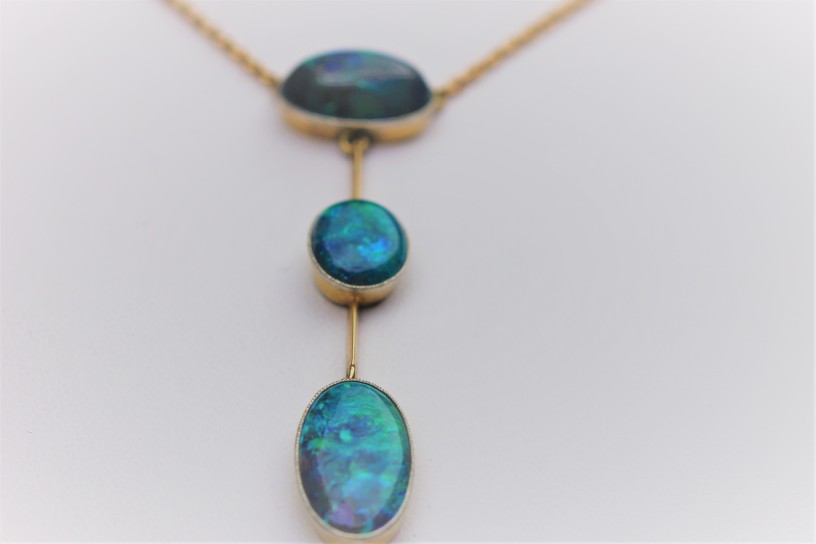The opal is Australia’s national gemstone. The first recorded discovery of opals in Australia was in 1872 in Queensland. Boulder opals, described below, were mined and were used primarily for cameo carving. Opals were discovered at White Cliffs in New South Wales in 1877 and commercial production began in 1890 but slowed and declined in the early 1900s. It was in 1903 that black opals were first commercially mined at Lightning Ridge, also in New South Wales. Australian white opals will only be found in Australian made and some English made jewellery from the 1890s onwards and black opals in the early 20th century.
Opals show what is described as ‘play of colour’. This is a display of rainbow-like colours which change with the direction you hold the stone. Opals are comprised of tiny silica spheres stacked together and it is light passing between voids in the stacks that causes the colours when the stone is moved.

Australia is the world’s biggest producer of opals. Black opal is mined in Lightning Ridge, NSW but Australia also produces white opal, crystal opal, boulder opal and matrix opal. There are opal fields in NSW, Queensland and South Australia. Coober Pedy in South Australia is the world’s largest opal mine and produces white opals, while Andamooka, also in South Australia, produces crystal opals.
The black opal is the most prized opal. It isn’t exactly black but is a stone with a dark or gray background against which the beautiful play of colour stands out. For some reason stones with red flashes of colour are more expensive than stones with mainly blues and green flashes but I like them all.

White opal, as the name suggests, has a white background with lovely play of colour. Crystal opal is a transparent or translucent stone, also with play of colour. Black, crystal and white opals are used in jewellery cut as cabochons.

Boulder opal occurs when the opal is attached as a surface layer to the underlying rock and really can’t be separated from it. It is found mainly in at the Queensland mines but also at Andamooka in South Australia. The boulder opal used in jewellery is usually freeform.

Matrix opal is where the opal has filled the pores of the host rock and is an integral part of it. These will also be cut as freeform stones.
One of the challenges in buying opals is that so much of it is either an opal doublet or opal triplet and it is often difficult to tell this. Opals can be quite thin and so the opal doublet was created to enable this thin slices of (normally) black opal to be used in jewellery. With a doublet, a slice of opal is cemented onto a dark base or a transparent material. An opal triplet is a composite consisting of three pieces – usually a transparent or translucent thin slice or lamination of natural opal which is cemented to a dark base material, with a top layer of clear material cemented over the top. It can be very hard to identify doublets set in jewellery. Generally, if the back of an opal set in jewellery is closed, then it is likely to be a doublet or triplet. The important point is that the seller of the opal must disclose to the buyer that the opal is a doublet or triplet and is not a solid opal.

Other producers of opal are Mexico, Nevada, US, Brazil, Slovakia and Ethiopia. Fire opal is mined mainly in Mexico but also in Oregon. Brazil produces crystal opals.

